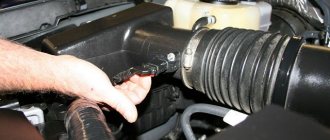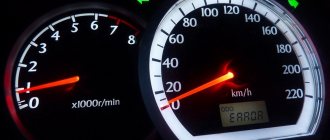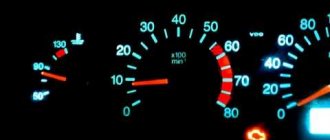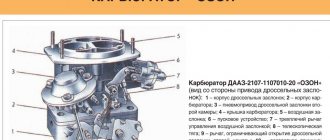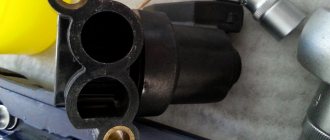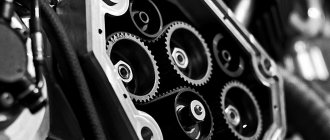Every vehicle owner, sooner or later, may experience problems associated with engine interruptions, regardless of the manufacturer and model of the car. Lada Priora is no exception. Therefore, as the owner of this car, you should be a little prepared for such situations so that they do not take you by surprise.
Drivers of the Lada Priora may encounter a situation where the engine speed fluctuates, often at idle. This is a problem for both vehicles with a carburetor and an injector in the configuration. Even the most popular foreign cars are not immune from such problems.
Your own diagnostician: why the engine speed fluctuates on a Priora - a theoretical basis
- failure of the mass air flow sensor (MAF);
- failure of the throttle position sensor (TPS);
- air leak;
- defective idle air controller (IAC).
What the engine will do in this state of affairs is to raise the speed of the power plant, while the volume of injected gasoline will remain the same. This means that the mixture will become leaner and the engine will begin to stall smoothly.
As the crankshaft speed decreases, the amount of air will decrease. After reaching a critical point, at which the injection volume of high-octane liquid is sufficient to obtain a combustible mixture of normal quality, engine operation stabilizes again. This process is called “floating revolutions”. It is closed and will be repeated until the causes are clarified and measures are taken to eliminate them.
Mechanical problems
First, you should check the throttle cable. Quite often it jams, and the pedal “sticks” when the driver has already removed his foot and the speed has not decreased. This may be due to the following problems:
- Corrosion of the cable
. At the same time, it simply gets stuck in the shirt; - Lubrication
. Sometimes drivers, in an effort to improve the operation of the unit, lubricate the cable; in winter, the lubricant freezes, which causes jamming;
Unsuccessful repair. In some cases, after repairs, car owners incorrectly position the cable, resulting in problems.
Therefore, be sure to check the condition of the cable. See how it moves and replace it if necessary.
Important: checking sensors
The answer to the question why the idle speed on a Priora fluctuates can often be this: one of the three sensors (IAC, TPS, MAF) is faulty. It's quite easy to check:
- Start the power plant.
- Disconnect the IAC power supply and analyze: the IAC frequency remains the same or the motor stalls - the sensor needs to be replaced. If the frequency has increased, the sensor is working.
- Restore power to the regulator.
- Remove the chip from the mass air flow sensor and observe: the speed has increased - the mass air flow sensor is working; the engine has stalled - the mass air flow sensor should be replaced.
- Connect power to the TPS.
- Disconnect the block from the mass air flow sensor and analyze: the crankshaft rotation speed has increased - the mass air flow sensor is working, the engine stalls - the throttle position sensor is faulty.
- Attach the chip to the mass air flow sensor.
For your information. Often the problem is caused by a poor connection of the terminals of both the “negative” and “positive” wires.
Reasons for an injector
Now let’s look at the reasons why injection engines have constantly high idle speeds. Unlike carburetor counterparts, where all the problems are with mechanical elements, the injector is stuffed with electronics, so this problem is a failure in the electronics.
The reasons may be:
- Malfunction or breakdown of the sensor that monitors the temperature of the coolant in the engine. If this sensor malfunctions, the speed is not reset, since the electronics believes that the engine has not yet warmed up and drives it in warm-up mode, which is why the increased speed remains. The problem can quickly overheat the engine and cause jamming of parts and severe damage, after which only expensive and time-consuming repairs. A diagnostic scanner can help identify this type of problem.
- A breakdown of the air sensor causes increased speed, as the correct air supply to the engine is disrupted. A diagnostic scanner can also help identify this malfunction. As well as problems with other sensors.
- After this, check the sensor using a multimeter to exclude a broken wiring as the cause.
- A malfunction of the sensor responsible for idle speed, if any, also causes malfunctions at idle speed. If after replacing the idle speed sensor the high speeds do not disappear, then it was not the cause.
- The throttle opening sensor also plays a key role when the speed increases. If it is not working correctly, the computer believes that the damper is fully open and increases the speed, supplying more fuel to the cylinders.
- The sensor may have nothing to do with it, the damper itself is jammed due to dirt, or the spring on the damper, which is supposed to close it, has stretched, in addition, this spring sometimes jumps off or breaks, so the engine keeps high speeds. In this case, it needs to be corrected, if possible, or replaced.
- The damper control cable is stuck. This malfunction was common in older car models. Then it’s worth lubricating or replacing this cable.
- The sealing gaskets on the injectors are damaged. This is a difficult malfunction to check, and quite rare, so it should be checked as a last resort, when other faults have been excluded. Broken gaskets allow air to enter the combustion chambers, which also increases speed.
Useful video about this problem
The injector also has many reasons for such a malfunction, and if it occurs, it is also worth taking care of solving it as soon as possible, before the problems become more serious.
This happened to a friend of mine due to a break in the wiring on the sensor connector, which he discovered after changing all possible sensors, and was about to reflash the computer’s brains. Therefore, in addition to the sensors, do not forget to check the fuses and the condition of the wiring. If there is no visual damage, you can check with a multimeter.
We recommend: Lada Vesta head unit - price, replacement, connection and pinout
This is what could be the reason for high engine speeds, the main thing is to quickly calculate and eliminate it, I have everything for today, subscribe your friends to updates, and subscribe yourself, there will be a lot of useful things, don’t forget to send a link to the site for those who don’t know about it yet, see you.
Route map for eliminating unstable XX on a VAZ 2170
Unstable idle is caused by the fact that the computer incorrectly perceives or does not know at all the amount of air sucked into the intake manifold. A typical treatment recipe looks like this:
- Check the sensors (IAC, DFID, TPS) and replace the faulty ones.
- Make sure that the adsorber valve is in good condition.
- If, after cleaning the throttle valve on the VAZ 21126 engine, the speed fluctuates, you need to make sure that there is no air leakage through the connections to the pipes.
- Check whether the diaphragm in the vacuum brake booster is intact.
The reliable carburetor engine control circuit has long been supplanted by flexible electronics. The latter consists of a control unit and sensors operating according to a specific program. This trend has made it possible to achieve an increase in power and a decrease in fuel consumption. However, with the advent of electronics, the control system has become more vulnerable to malfunctions.
Advantages and disadvantages of an electronic pedal
Over the 7 years of operation of the Lada Priora with an electronic throttle control system, car enthusiasts have compiled pronounced pros and cons of operating a car with e-gas.
Advantages:
- Reduced fuel consumption. If you press the gas too hard, the ECU will correct this moment and prevent either overspeeding or increased fuel consumption. “Over-gassing” will not work;
- Environmental friendliness. The introduction of this system took place under the influence of the popular movement of automakers who bring their cars to European standards. Priora is Euro 4 compliant;
- Instant response of the car to pressing the accelerator lever (only if the system is working properly).
Your own diagnostician: why the engine speed fluctuates on a Priora - a theoretical basis
- failure of the mass air flow sensor (MAF);
- failure of the throttle position sensor (TPS);
- air leak;
- defective idle air controller (IAC).
What the engine will do in this state of affairs is to raise the speed of the power plant, while the volume of injected gasoline will remain the same. This means that the mixture will become leaner and the engine will begin to stall smoothly.
As the crankshaft speed decreases, the amount of air will decrease. After reaching a critical point, at which the injection volume of high-octane liquid is sufficient to obtain a combustible mixture of normal quality, engine operation stabilizes again. This process is called “floating revolutions”. It is closed and will be repeated until the causes are clarified and measures are taken to eliminate them.
Problems with the carburetor system
When releasing gas, the drop in speed can be bad for both injectors and carburetor systems.
If the car has a carburetor, then there may be several defects.
Most often, the speed does not drop due to a faulty throttle valve. When the engine warms up, it is in the open position to allow more air into the system. Then it closes and the speed should drop.
If the throttle valve is not closed completely, the mixture will still be over-rich when the operating temperature is reached, and the speed will remain at the same level. If this part is heavily soiled or deformed, it cannot close completely.
You can clean the damper using a special product, which can be purchased at an automotive supply store. Deformation may require replacing the carburetor completely. The damper may not close tightly if the drive cable is severely worn. Replacing it may improve the situation.
Another common reason why the engine speed does not drop when idling is the gasket between the carburetor and the cylinder head, which has become unusable, or a damaged intake manifold.
After replacing the carburetor or cleaning the power system, you can often notice that the engine speed is slowly dropping. This occurs due to improper adjustment of the idle system; an over-enriched air-fuel mixture is often supplied. To eliminate the malfunction, it is necessary to adjust the ratio of fuel and air supply to the system.
Important: checking sensors
The answer to the question why the idle speed on a Priora fluctuates can often be this: one of the three sensors (IAC, TPS, MAF) is faulty. It's quite easy to check:
- Start the power plant.
- Disconnect the IAC power supply and analyze: the IAC frequency remains the same or the motor stalls - the sensor needs to be replaced. If the frequency has increased, the sensor is working.
- Restore power to the regulator.
- Remove the chip from the mass air flow sensor and observe: the speed has increased - the mass air flow sensor is working; the engine has stalled - the mass air flow sensor should be replaced.
- Connect power to the TPS.
- Disconnect the block from the mass air flow sensor and analyze: the crankshaft rotation speed has increased - the mass air flow sensor is working, the engine stalls - the throttle position sensor is faulty.
- Attach the chip to the mass air flow sensor.
For your information. Often the problem is caused by a poor connection of the terminals of both the “negative” and “positive” wires.
Route map for eliminating unstable XX on a VAZ 2170
Unstable idle is caused by the fact that the computer incorrectly perceives or does not know at all the amount of air sucked into the intake manifold. A typical treatment recipe looks like this:
- Check the sensors (IAC, DFID, TPS) and replace the faulty ones.
- Make sure that the adsorber valve is in good condition.
- If, after cleaning the throttle valve on the VAZ 21126 engine, the speed fluctuates, you need to make sure that there is no air leakage through the connections to the pipes.
- Check whether the diaphragm in the vacuum brake booster is intact.
When the speed started to fluctuate, I changed the spark plugs and the idle speed sensor, but it didn’t help.
Comments 25
I also have the same problem. But I think it’s the spark plugs, the coil is causing some kind of failure or the filters (air, fuel) Or am I wrong, this can’t be the case?
Good evening everyone. I have a 2010 Priora 1.6 16 valve. The revs fluctuated and stalled. No diagnostics showed anything ((thought I could fix it myself
